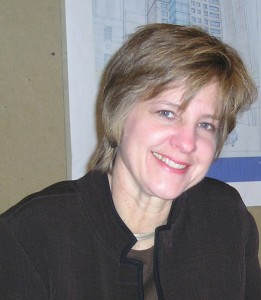Cheryl Tougias likes a good cup of coffee.
The topic came up in discussing her professional background. Tougias is an architect and founding partner of Spalding Tougias, a firm that often works on structures whose original purpose has fallen out of use. I asked if the Brewery Building in JP, which houses the killer Ula Cafe, was an example of the type of project her firm might be involved with. Hence the minor segue to coffee. The firm has worked on a variety of projects over the years including work with commercial developers and non-profits. You can review a current project that the Spalding Tougias firm is involved with here.
“I knew I wanted to be an architect in the 9th grade.”
In addition to coffee, Tougias likes to plan things. She asked for the questions for this interview in advance. This was a first. So I learned something about architects and Cheryl Tougias. Whether she likes to plan because she became an architect or became an architect because she likes to plan is perhaps answered when she says, “I knew I wanted to be an architect in the 9th grade.”
She moved to Milton with her husband in 1998. They live here with their two children, who attend the Cunningham Elementary School where she is a member of the Cunningham PTO. Ms. Tougias is also a member of Sustainable Milton.
“There are times when I have fallen short.”
Everyone has their ups and downs. Ms. Tougias, as the owner of a business, has seen her share. On the down side, the hardest thing she has ever had to do is lay off employees during challenging times, knowing that positions are hard to find. It is a cyclical business but it is not without its rewards. Tougias takes pride in being able to revitalize buildings and neighborhoods in the process. She works with the “end-users” and the reward is in making “contributions to communities block by block.”
It is work that requires building consensus, working with different constituencies, patience, and perseverance. Tougias notes, “I continuously challenge myself to see things from different perspectives before drawing conclusions. There are times when I have fallen short.”
It was this extensive professional experience that prompted her to volunteer when the Planning Board was seeking members for an Advisory Committee regarding the Temple Shalom property which was being considered for a zoning overlay.
“You have to work towards moving things forward.”
Tougias makes several observations when reflecting on the Shalom experience. It is her belief that “a lot of work went into that – that was not communicated” and that the Planning Board “did a commendable job asking developer to respond to requests made by the community. They sought out peer review.”
More effective communication might have resulted in a “different type of engagement.” Tougias argues that, “You have to work towards moving things forward. [One can] work to stop something but what is going to happen after that?”
In the final analysis “the Temple is something we need to come back to . . . [it] should be discussed and addressed.” She is seriously concerned about the prospect of the Temple leaving the site, a situation in which safety will be potentially compromised and property values impacted. “Is that a better outcome?” she asks.
“This is what I have been doing for twenty-five years.”
Anyone who served on the Temple Shalom Advisory Committee certainly isn’t going to be accused of running for the Planning Board with their eyes closed. Tougias knows what she is getting into and believes she has the skill set and experience to deal with the inevitable, change. “Change is going to happen,” she says and therefore there is a need to anticipate it and plan for it. “The board needs to be proactive not reactive.” As an example she cites the St Pious property, recommending that the board look ahead now and engage the community now so that when proposals come up they might have some chance of success.
When asked why she is running, Tougias gives an answer heard frequently. Namely, she wants to be able to contribute her skill set to the town. In Tougias’s case that consists of evaluating land use, planning and design review. She notes, “This is what the Planning Board does. This is what I have been doing for twenty-five years.”
